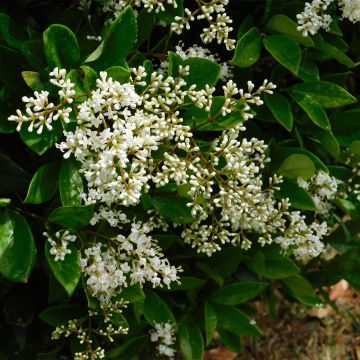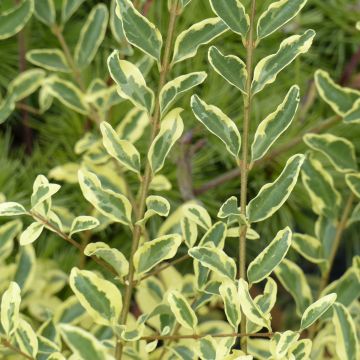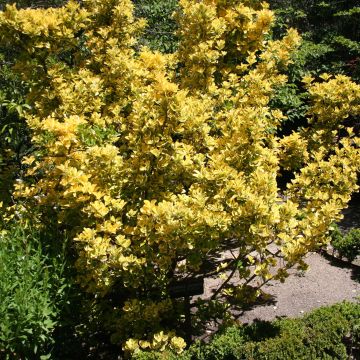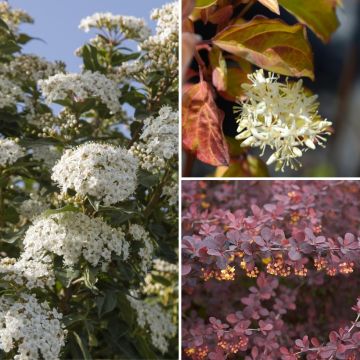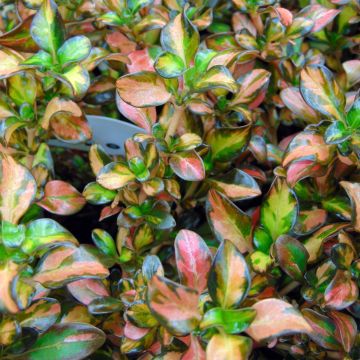

Ligustrum obtusifolium var. regelianum - Troène à feuilles obtuses


Ligustrum obtusifolium var. regelianum - Troène à feuilles obtuses
Ligustrum obtusifolium Regelianum - Privet
Ligustrum obtusifolium 'Regelianum'
Border Privet, Amur Privet
Interesting plant with a habit that is not common for a Ligustrum. It has developed very well. It has tripled in size. Very good.
Michel RIVIERE, 31/08/2024
Special offer!
Receive a €20 voucher for any order over €90 (excluding delivery costs, credit notes, and plastic-free options)!
1- Add your favorite plants to your cart.
2- Once you have reached €90, confirm your order (you can even choose the delivery date!).
3- As soon as your order is shipped, you will receive an email containing your voucher code, valid for 3 months (90 days).
Your voucher is unique and can only be used once, for any order with a minimum value of €20, excluding delivery costs.
Can be combined with other current offers, non-divisible and non-refundable.
Home or relay delivery (depending on size and destination)
Schedule delivery date,
and select date in basket
This plant carries a 24 months recovery warranty
More information
We guarantee the quality of our plants for a full growing cycle, and will replace at our expense any plant that fails to recover under normal climatic and planting conditions.
Would this plant suit my garden?
Set up your Plantfit profile →
Description
The Ligustrum obtusifolium 'Regelianum' is a variety of privet with blunt leaves that combines many qualities, making it an excellent bush for hedges or beds that we should plant more often in our gardens. With an unusual habit, it offers remarkable white summer flowering, followed by an abundant blue-black fruiting that persists until winter. Under the effect of the cold, its leaves take on superb purplish colours, which they retain for several weeks before falling. This hardy and undemanding bush adapts to all types of soil, from dry to fresh, acidic to limey, but not too poor soil. Its flowers feed bees and its fruits are a delight for birds.
Also known as Ligustrum obtusifolium var. regelianum, this bush from the Oleaceae family is native to Japan. Its foliage is generally deciduous in winter, but it may partially persist in a mild climate. At maturity, it will reach an average of 1.75 m (5 ft 8 in) in all directions (up to 2 m (6 ft 7 in) under very favourable conditions). Its annual growth is on the order of 10-15 cm (3.9-5.9 in) in all directions. The well-ramified plant develops slightly pendulous branches that spread horizontally. It presents a tiered bushy habit. Its pubescent branches bear leaves arranged in an opposite manner, in tight ranks on the same plane. The leaves are entire, elliptical to elongate ovate, measuring between 5.5 and 8 cm (2.2 and 3.1 in) in length and 1.5 to 2 cm (0.6 to 0.8 in) in width. Their colour is bright green on top, with a grey-green underside. In the autumn, they turn to purple and then to a brownish-violet to bluish-violet, beautiful shades that they retain for several weeks. The flowering, particularly abundant, takes place in June-July. It takes the form of short conical clusters, dense and upright, appearing at the end of each branch. Each inflorescence is composed of numerous small creamy white flowers, melliferous and slightly fragrant. They give way to small blue-black berries at ripeness, provided the bush is not pruned. All parts of the privet are toxic if ingested.
The Ligustrum obtusifolium 'Regelianum', of real elegance, can be used in multiple ways: in hedges, alone, in shrub beds, or even in a large rockery. Its moderate growth frees the gardener from any pruning, even when it is installed in a shared hedge. Also combine it with other easy-care bushes, for example rockery conifers, evergreen viburnums, Abelias, lilacs, Berberis
Report an error about the product description
Plant habit
Flowering
Foliage
Botanical data
Ligustrum
obtusifolium
'Regelianum'
Oleaceae
Border Privet, Amur Privet
Southeast Asia
Other Ligustrum - Privet
View all →Planting and care
The Ligustrum obtusifolium 'Regelianum' is planted in the spring or in the autumn at 1.50 m (4 ft 11 in) spacing for the hedges. Dig a hole twice and a half the pot at least, loosen the bottom and deposit a large handful of horticultural compost or mix slow-release fertiliser with the loose soil. Water well, especially the first summers, mulch the soil to keep the freshness. You can avoid pruning. Its pretty habit would suffer and its moderate development allows it. If you need to prune, proceed at the end of winter or at the end of summer.
This bush is not very demanding in terms of soil, it will even adapt in limestone soil if the planting is cared for. On the other hand, soils that are too poor (sandy, peaty, heathland, very stony) are not suitable for it at all. Once well established, it totally does without watering in the summer in the vast majority of our regions. Privets are quite resistant to parasites and diseases. However, they can be affected by weevil larvae or caterpillars.
Planting period
Intended location
Care
-
, onOrder confirmed
Reply from on Promesse de fleurs
Similar products
Haven't found what you were looking for?
Hardiness is the lowest winter temperature a plant can endure without suffering serious damage or even dying. However, hardiness is affected by location (a sheltered area, such as a patio), protection (winter cover) and soil type (hardiness is improved by well-drained soil).

Photo Sharing Terms & Conditions
In order to encourage gardeners to interact and share their experiences, Promesse de fleurs offers various media enabling content to be uploaded onto its Site - in particular via the ‘Photo sharing’ module.
The User agrees to refrain from:
- Posting any content that is illegal, prejudicial, insulting, racist, inciteful to hatred, revisionist, contrary to public decency, that infringes on privacy or on the privacy rights of third parties, in particular the publicity rights of persons and goods, intellectual property rights, or the right to privacy.
- Submitting content on behalf of a third party;
- Impersonate the identity of a third party and/or publish any personal information about a third party;
In general, the User undertakes to refrain from any unethical behaviour.
All Content (in particular text, comments, files, images, photos, videos, creative works, etc.), which may be subject to property or intellectual property rights, image or other private rights, shall remain the property of the User, subject to the limited rights granted by the terms of the licence granted by Promesse de fleurs as stated below. Users are at liberty to publish or not to publish such Content on the Site, notably via the ‘Photo Sharing’ facility, and accept that this Content shall be made public and freely accessible, notably on the Internet.
Users further acknowledge, undertake to have ,and guarantee that they hold all necessary rights and permissions to publish such material on the Site, in particular with regard to the legislation in force pertaining to any privacy, property, intellectual property, image, or contractual rights, or rights of any other nature. By publishing such Content on the Site, Users acknowledge accepting full liability as publishers of the Content within the meaning of the law, and grant Promesse de fleurs, free of charge, an inclusive, worldwide licence for the said Content for the entire duration of its publication, including all reproduction, representation, up/downloading, displaying, performing, transmission, and storage rights.
Users also grant permission for their name to be linked to the Content and accept that this link may not always be made available.
By engaging in posting material, Users consent to their Content becoming automatically accessible on the Internet, in particular on other sites and/or blogs and/or web pages of the Promesse de fleurs site, including in particular social pages and the Promesse de fleurs catalogue.
Users may secure the removal of entrusted content free of charge by issuing a simple request via our contact form.
The flowering period indicated on our website applies to countries and regions located in USDA zone 8 (France, the United Kingdom, Ireland, the Netherlands, etc.)
It will vary according to where you live:
- In zones 9 to 10 (Italy, Spain, Greece, etc.), flowering will occur about 2 to 4 weeks earlier.
- In zones 6 to 7 (Germany, Poland, Slovenia, and lower mountainous regions), flowering will be delayed by 2 to 3 weeks.
- In zone 5 (Central Europe, Scandinavia), blooming will be delayed by 3 to 5 weeks.
In temperate climates, pruning of spring-flowering shrubs (forsythia, spireas, etc.) should be done just after flowering.
Pruning of summer-flowering shrubs (Indian Lilac, Perovskia, etc.) can be done in winter or spring.
In cold regions as well as with frost-sensitive plants, avoid pruning too early when severe frosts may still occur.
The planting period indicated on our website applies to countries and regions located in USDA zone 8 (France, United Kingdom, Ireland, Netherlands).
It will vary according to where you live:
- In Mediterranean zones (Marseille, Madrid, Milan, etc.), autumn and winter are the best planting periods.
- In continental zones (Strasbourg, Munich, Vienna, etc.), delay planting by 2 to 3 weeks in spring and bring it forward by 2 to 4 weeks in autumn.
- In mountainous regions (the Alps, Pyrenees, Carpathians, etc.), it is best to plant in late spring (May-June) or late summer (August-September).
The harvesting period indicated on our website applies to countries and regions in USDA zone 8 (France, England, Ireland, the Netherlands).
In colder areas (Scandinavia, Poland, Austria...) fruit and vegetable harvests are likely to be delayed by 3-4 weeks.
In warmer areas (Italy, Spain, Greece, etc.), harvesting will probably take place earlier, depending on weather conditions.
The sowing periods indicated on our website apply to countries and regions within USDA Zone 8 (France, UK, Ireland, Netherlands).
In colder areas (Scandinavia, Poland, Austria...), delay any outdoor sowing by 3-4 weeks, or sow under glass.
In warmer climes (Italy, Spain, Greece, etc.), bring outdoor sowing forward by a few weeks.































